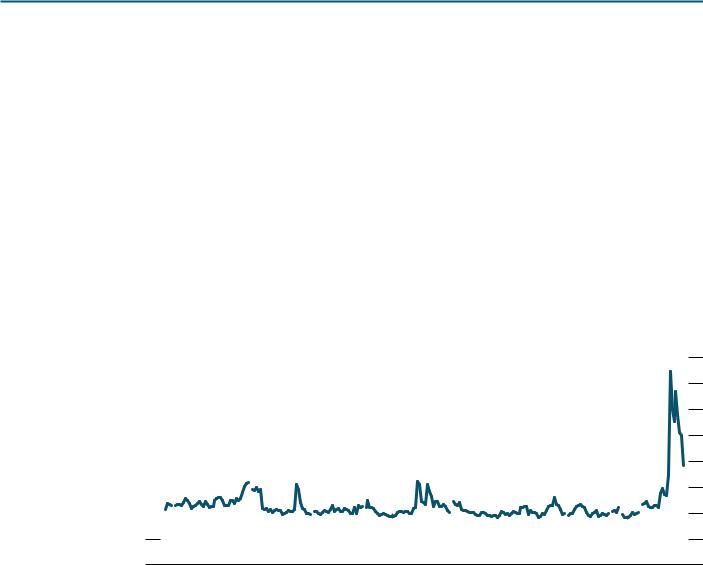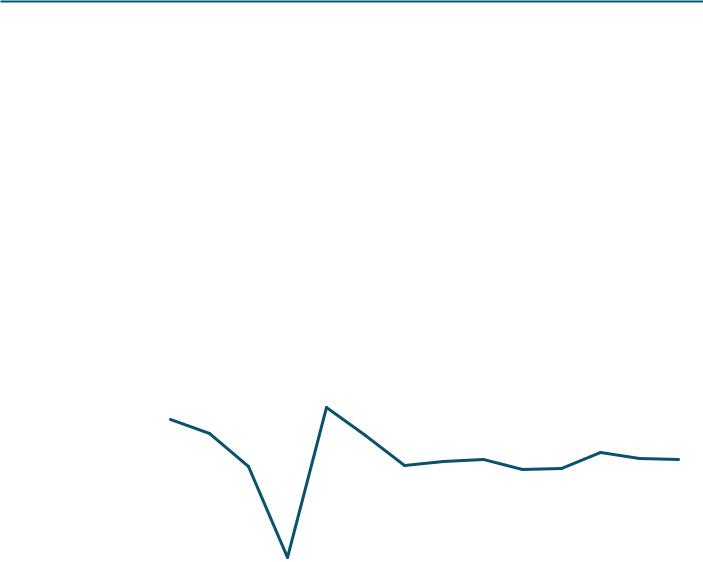
EIU_Top10_Risks_to_the_Global_Economy_2019_watermark
.pdf
vk.com/id446425943
Cause for concern?
The top 10 risks to the global economy
A report by The Economist Intelligence Unit

vk.com/id446425943
The world leader in global business intelligence
The Economist Intelligence Unit (The EIU) is the research and analysis division of The Economist Group, the sister company to The Economist newspaper. Created in 1946, we have over 70 years’ experience in helping businesses, financial firms and
governments to understand how the world is changing and how that creates opportunities to be seized and risks to be managed.
Given that many of the issues facing the world have an international (if not global) dimension, The EIU is ideally positioned to be commentator, interpreter and forecaster on the phenomenon of globalisation as it gathers pace and impact.
EIU subscription services
The world’s leading organisations rely on our subscription services for data, analysis and forecasts to keep them informed about what is happening around the world. We specialise in:
•Country Analysis: Access to regular, detailed country-specific economic and political forecasts, as well as assessments of the business and regulatory environments in different markets.
•Risk Analysis: Our risk services identify actual and potential threats around the world and help our clients understand the implications for their organisations.
•Industry Analysis: Five year forecasts, analysis of key themes and news analysis for six key industries in 60 major economies. These forecasts are based on the latest data and in-depth analysis of industry trends.
EIU Consulting
EIU Consulting is a bespoke service designed to provide solutions specific to our customers’ needs. We specialise in these key sectors:
•Consumer: Providing data-driven solutions for consumer-facing industries, our management consulting firm, EIU Canback, helps clients to enter new markets and deliver greater success in current markets. Find out more at: eiu.com/consumer
•Healthcare: Together with our two specialised consultancies, Bazian and Clearstate, The EIU helps healthcare organisations build and maintain successful and sustainable businesses across the healthcare ecosystem. Find out more at: eiu.com/ healthcare
•Public Policy: Trusted by the sector’s most influential stakeholders, our global public policy practice provides evidencebased research for policy-makers and stakeholders seeking clear and measurable outcomes. Find out more at: eiu.com/ publicpolicy
The Economist Corporate Network
The Economist Corporate Network (ECN) is The Economist Group’s advisory service for organisational leaders seeking to better understand the economic and business environments of global markets. Delivering independent, thought-provoking content, ECN provides clients with the knowledge, insight, and interaction that support better-informed strategies and decisions.
The Network is part of The Economist Intelligence Unit and is led by experts with in-depth understanding of the geographies and markets they oversee. The Network’s membership-based operations cover Asia-Pacific, the Middle East, and Africa. Through a distinctive blend of interactive conferences, specially designed events, C-suite discussions, member briefings, and high-calibre research, The Economist Corporate Network delivers a range of macro (global, regional, national, and territorial) as well as industry-focused analysis on prevailing conditions and forecast trends.

vk.com/id446425943
CAUSE FOR CONCERN?
THE TOP 10 RISKS TO THE GLOBAL ECONOMY
Contents
Executive summary |
2 |
The axis of risk |
3 |
Prolonged fall in major stockmarkets destabilises the global economy |
5 |
Global trade slumps as US steps up protectionist policies |
7 |
Territorial disputes in the South China Sea lead to an outbreak of hostilities |
9 |
Global growth surges above 4% |
11 |
A major cyber-attack cripples corporate and government activities |
12 |
China suffers a disorderly and prolonged economic downturn |
13 |
There is a major military confrontation on the Korean Peninsula |
15 |
Proxy conflicts in the Middle East escalate into direct confrontations that cripple global energy |
|
markets |
16 |
Oil prices fall significantly after the OPEC deal to curb production breaks down |
17 |
Multiple countries withdraw from the euro zone |
19 |
1 |
© The Economist Intelligence Unit Limited 2018 |

vk.com/id446425943
CAUSE FOR CONCERN?
THE TOP 10 RISKS TO THE GLOBAL ECONOMY
Executive summary
There has arguably never been a greater disconnect between the apparent strength of the global economy and the magnitude of geopolitical, financial and operational risks that organisations
are facing.
The Economist Intelligence Unit expects momentum in the global economy to remain strong in 2018. The US economy will continue to motor along, the euro area will absorb more of the slack in its labour markets and Chinese consumption, investment and exports will all remain strong. Higher commodity prices will prove a fillip for emerging-market exporters, while a gradual tightening of monetary conditions will not take hold to the extent that it slows growth. Taken together, these factors mean that the global economy is forecast to expand by 3% in 2018, up from a mediocre annual average pace of 2.6% in 2015-16.
Despite the encouraging headline growth figures, the global economy is facing the highest level of risk in years. Indeed, this favourable economic picture appears to come from a completely different world to the one where headlines are dominated by protectionist rhetoric, major territorial disputes, terrorism, surging cyber-crime and even the threat of nuclear war. The global economy has seen periods of high risk before, with threats emanating from the regional and the national level, as well as from state and non-state actors. What is unique about this period of heightened risk, however,
is that unlike other periods in recent decades, risks are also originating from the global level, as the US questions its role in the world and partially abdicates from its responsibilities. These moves have signalled the end of the US-led global order and the beginning of a new order. Although the new order will emerge over the next decade, there will be a period of uncertainty as multiple global and regional
powers vie for power and influence. For organisations attempting to negotiate these concerns in order to take advantage of the numerous and growing economic opportunities, the stakes are obviously high.
In this report we identify and assess the top ten risks to the global political and economic order. Each of the risks is not only outlined, but also rated in terms of its likelihood and its potential impact on the global economy. This is a small snapshot of our risk quantification capabilities. We also provide operational risk analysis on a country-by-country basis for 180 countries through our Risk Briefing. Meanwhile, we provide detailed credit risk assessments on 131 countries via our Country Risk Service. Together, these products enable our clients to plot the main threats to their organisations, supply chains and sovereign creditors. We offer robust risk modelling, scenario analysis and daily events scanning for the threats and opportunities that abound in the global economy.
2 |
© The Economist Intelligence Unit Limited 2018 |

vk.com/id446425943
CAUSE FOR CONCERN?
THE TOP 10 RISKS TO THE GLOBAL ECONOMY
The axis of risk
When measuring risk to the global economy it is of little surprise to see many potential challenges emerging from the world’s largest economies. The Economist Intelligence Unit sees a number of risks, with their roots in the US, China and the EU. However, these risks are not limited to those geographies alone, and how they could morph into threats that destabilise large parts of the world is detailed in the following pages. In addition, there are risks that either come from smaller regional hotspots, or are global in nature. Again, we look at how they could evolve in the coming years and what that would mean for transnational organisations.
Global risk scenarios
|
Political |
|
Military |
|
Financial |
|
|
|
|
||||
|
|
|
|
|
|
|
US administration turns |
|
|
|
|||
protectionist rhetoric |
|
|
|
|||
|
|
|
||||
into action |
|
|
|
|
|
|
|
|
|
|
|
|
|
Equity market crisis triggers economic recession 

Major cyber-attack cripples online activity
War on the Korean peninsula
China economic crisis |
Outbreak of major |
hostilities in South |
China Sea |
Oil prices slump |
|
Multiple countries exit |
|
Proxy conflicts in the |
as OPEC deal fails |
|
the euro zone |
|
Middle East turn overt |
|
|
|
|
|
3 |
© The Economist Intelligence Unit Limited 2018 |

vk.com/id446425943
CAUSE FOR CONCERN?
THE TOP 10 RISKS TO THE GLOBAL ECONOMY
Top 10 global risks in order of intensity
Rank |
Intensity |
Scenario |
|
|
|
=1 |
15 |
Prolonged fall in major stockmarkets destabilises the global economy |
|
|
|
=1 |
15 |
Global trade slumps as US steps up protectionist policies |
|
|
|
=2 |
12 |
Territorial disputes in the South China Sea lead to an outbreak of hostilities |
|
|
|
=2 |
12 |
Global growth surges above 4% |
|
|
|
=2 |
12 |
A major cyber-attack cripples corporate and government activities |
=3 |
10 |
China suffers a disorderly and prolonged economic downturn |
|
|
|
=3 |
10 |
There is a major military confrontation on the Korean Peninsula |
|
|
|
=3 |
10 |
Proxy conflicts in the Middle East escalate into direct confrontations that cripple global energy markets |
|
|
|
4 |
9 |
Oil prices fall significantly after the OPEC deal to curb production breaks down |
5 |
5 |
Multiple countries withdraw from the euro zone |
This table highlights The Economist Intelligence Unit’s top 10 global risks, ranked in order of intensity. Risk intensity here is measured on a 25-point scale, and is a product of the probability of that risk taking place and the potential impact it would have on the global economy.
Each risk will be analysed in great detail this report, and the probability and impact of each risk will be classified according to the following categories:
Probability
Very high risk = greater than 40% probability that the scenario will occur over the next two years
High = 31-40%
Moderate = 21-30%
Low = 11-20%
Very low = 0-10%
Impact
Very high impact = change to global annual GDP compared with the baseline forecast of 2% or more (increase in GDP for positive scenarios, decrease for negative scenarios)
High = 1-1.9%
Moderate = 0.5-0.9%
Low = 0.2-0.5%
Very low = 0-0.1%
4 |
© The Economist Intelligence Unit Limited 2018 |

vk.com/id446425943
CAUSE FOR CONCERN?
THE TOP 10 RISKS TO THE GLOBAL ECONOMY
Prolonged fall in major stockmarkets destabilises the global economy
Intensity=15
Moderate probability, Very high impact
Introduction
Global stockmarkets entered a period of pronounced volatility in early February after a long bull market, raising some concern that it could be the start of a more pronounced downturn.
A spike in volatility as markets are unnerved
(VIX volatility index measures market expectation of near-term volatility conveyed by stock index option prices)
40 |
|
|
|
|
|
|
|
|
|
|
40 |
35 |
|
|
|
|
|
|
|
|
|
|
35 |
30 |
|
|
|
|
|
|
|
|
|
|
30 |
25 |
|
|
|
|
|
|
|
|
|
|
25 |
20 |
|
|
|
|
|
|
|
|
|
|
20 |
15 |
|
|
|
|
|
|
|
|
|
|
15 |
10 |
|
|
|
|
|
|
|
|
|
|
10 |
5 |
|
|
|
|
|
|
|
|
|
|
5 |
0 |
|
|
|
|
|
|
|
|
|
|
0 |
Feb Mar |
Apr |
May |
Jun |
Jul |
Aug |
Sep |
Oct |
Nov |
Dec |
Jan |
Feb |
2017 |
|
|
|
|
|
|
|
|
|
18 |
|
Source: Chicago Board Options Exchange, CBOE Volatility Index: VIX [VIXCLS], FRED, Federal Reserve Bank of St. Louis.
Analysis
The proximate cause of this recent volatility was a US jobs data release, which showed an acceleration in nominal year-on-year wage growth. This increase gave rise to concerns that wage growth could accelerate quickly in the coming months, forcing the Federal Reserve (Fed, the US central bank) to tighten monetary policy more quickly than expected. Markets have proved to be highly sensitive to speculation over monetary policy owing to uncertainty over how much of the previous bullishness was due to quantitative easing (QE) across much of the developed world, which depressed interest rates, thus making shares more attractive. Although company earnings have been increasing, which would augur well for share price increases, this is in no small part attributable to the ultra-low interest rates at which companies are able to borrow. The true impact of QE on company valuations will become known over the next two years as the Fed gradually unwinds its QE programme and tightens monetary policy. There is a risk that share prices will crash in the US, which would lead to contagion around
5 |
© The Economist Intelligence Unit Limited 2018 |

vk.com/id446425943
CAUSE FOR CONCERN?
THE TOP 10 RISKS TO THE GLOBAL ECONOMY
the world. A prolonged period of decline would pose major risks to our global economic outlook. Households would see a decline in the value of financial assets, triggering lower consumer spending. Meanwhile, the credit channel that funnels loans to the private sector would be impaired; where banks experience sharp declines in their valuations, their ability and willingness to lend to businesses also falls. This effect would be most significant for highly leveraged small and medium-sized enterprises, resulting in lower investment and job creation.
Conclusion
The global economy is moving into a new phase, where more and more central banks will begin to wind down or reverse their loose monetary policy positions in response to vigorous growth rates, giving rise to significant uncertainty.
6 |
© The Economist Intelligence Unit Limited 2018 |

vk.com/id446425943
CAUSE FOR CONCERN?
THE TOP 10 RISKS TO THE GLOBAL ECONOMY
Global trade slumps as US steps up protectionist policies
Intensity=15
Moderate probability, Very high impact
Introduction
We currently expect further strong global trade growth in 2018-19, buoyed by strong emerging-market export growth and robust Chinese economic growth. However, there is a risk that the administration of the US president, Donald Trump, translates its protectionist rhetoric into more concrete action that severely damages global trade channels.
Trade at stake
(% increase year on year in world trade of goods and services under EIU central scenario)
15.0 |
|
|
|
|
|
|
|
|
|
|
|
|
15.0 |
|
10.0 |
|
|
|
|
|
|
|
|
|
|
|
|
10.0 |
|
5.0 |
|
|
|
|
|
|
|
|
|
|
|
|
|
5.0 |
0.0 |
|
|
|
|
|
|
|
|
|
|
|
|
0.0 |
|
-5.0 |
|
|
|
|
|
|
|
|
|
|
|
|
-5.0 |
|
|
|
|
|
|
|
|
|
|
|
|
|
|
|
|
-10.0 |
|
|
|
|
|
|
|
|
|
|
|
|
-10.0 |
|
-15.0 |
|
|
|
|
|
|
|
|
|
|
|
|
-15.0 |
|
2006 |
07 |
08 |
09 |
10 |
11 |
12 |
13 |
14 |
15 |
16 |
17 |
18 |
19 |
|
Note: IMF data for 2006-16; EIU estimate for 2017; EIU forecasts for 2018-19.
Sources: IMF; The Economist Intelligence Unit.
Analysis
The two central scenarios that we are primarily concerned about is a US withdrawal from the North American Free-Trade Agreement (NAFTA) and restrictive measures taken by the US against China that instigate a trade war. Negotiations on revising the NAFTA agreement are under way—including the January round of negotiations that were viewed positively—and our base forecast is that these will result in a new agreement later in the year. However, there remains a risk that, frustrated with the progress of negotiations and viewing the US as “losing” on trade, Mr Trump will attempt to pull the US out of NAFTA. US withdrawal from NAFTA (or even just a rise in uncertainty over its membership participation) would create enormous ructions in one of the largest free-trade areas in the world. An end to such a major trade deal would be likely to fuel protectionist sentiment elsewhere in the world, making it harder for regions and countries like the EU and Japan to push a more liberal trade agenda.
7 |
© The Economist Intelligence Unit Limited 2018 |

vk.com/id446425943
CAUSE FOR CONCERN?
THE TOP 10 RISKS TO THE GLOBAL ECONOMY
During the NAFTA negotiations, the US has been ramping up measures that either directly or indirectly target China’s exports. The US has imposed tariffs on the import of solar cells and washing machines, and has multiple ongoing investigations into dumping and theft of intellectual property by China. There is a danger that these trade disputes will escalate into a full-blown trade war if China were to retaliate disproportionately. (So far China has been more measured, launching, for example, an investigation into US sorghum imports.)
Conclusion
Any ramp-up in protectionism would certainly have repercussions beyond North America and China. Prices and availability for US and Chinese products in the supply chains of companies from other nations would be badly affected. Consequently, global growth would be notably curtailed as investment and consumer spending fall back.
8 |
© The Economist Intelligence Unit Limited 2018 |
